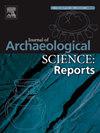New insights into human behavior at Liang Bua (Flores, Indonesia) based on the temporal distribution of pottery and mollusks during the past 5000 years
IF 1.5
2区 历史学
0 ARCHAEOLOGY
引用次数: 0
Abstract
In addition to preserving a rich archaeological record spanning from ∼190 thousand years ago (ka) until the terminal Pleistocene, Liang Bua (Flores, Indonesia) also preserves a rich and relatively complete Holocene stratigraphic sequence with dense accumulations of faunal remains, stone artifacts, and pottery. In this study, abundances of pottery sherds and mollusk taxa were examined across nine stratigraphic units to explore temporal variation during the past ∼5000 years. This temporal period is important because it is during this time that archaeological evidence of agriculture and sedentism initially appears on Flores. The first aim of this study was to more precisely determine when pottery was first introduced to the site as previous research has suggested that this occurred either ∼4 ka or ∼3 ka. The second aim of this study was to document the mollusk assemblage at Liang Bua in terms of its temporal range and taxonomic composition. Particular emphasis was placed on determining whether humans were responsible for accumulating all or part of this mollusk assemblage, which included 3515 three-dimensionally-plotted specimens and 4270 specimens recovered from sieved sediments.
Our results show that pottery was most likely first introduced to the site ∼3.3 ka and used regularly after ∼3 ka, suggesting increased sedentism or farming in the areas surrounding the cave. The main shell midden at Liang Bua was deposited between ∼4.4 and 3.3 ka and includes mostly freshwater species. Interestingly, 63.1 % of Tarebia granifera and 66.7 % of Melanoides tuberculata recovered in Sectors XXXII-XXIX showed signs that they were deliberately broken open at their apices. Deliberately opening the apex of a shell is almost certainly a strategy to obtain the meat for human consumption. Furthermore, the presence of 12 culturally modified marine shells at Liang Bua suggests that, after ∼4.4–4.3 ka, past peoples living around Liang Bua had strong social and/or symbolic connections to coastal areas either through their own foraging ranges or through trade networks with other peoples living nearer to the ocean.
根据过去 5000 年陶器和软体动物的时间分布对良布阿(印度尼西亚弗洛勒斯岛)人类行为的新认识
梁布阿(印度尼西亚弗洛勒斯岛)除了保存了19万年前至更新世末期的丰富考古记录外,还保存了丰富且相对完整的全新世地层序列,其中有大量动物遗骸、石器和陶器。本研究对九个地层单元的陶器碎片和软体动物类群的丰度进行了研究,以探讨过去∼5000 年间的时间变化。这一时期非常重要,因为正是在这一时期,弗洛勒斯岛最初出现了农业和定居的考古证据。本研究的第一个目的是更准确地确定陶器首次出现在该遗址的时间,因为之前的研究认为陶器出现在 4 ka 或 3 ka。本研究的第二个目的是记录梁布阿软体动物群的时间范围和分类组成。我们的研究结果表明,陶器很可能是在3.3 ka∼3ka年间首次引入该遗址,并在∼3 ka∼3ka之后被定期使用,这表明洞穴周边地区的定居或农耕活动有所增加。梁布阿的主要贝冢沉积于 ∼4.4 ∼3.3 ka 之间,主要包括淡水物种。有趣的是,在第三十二至三十九区出土的 63.1%的 Tarebia granifera 和 66.7%的 Melanoides tuberculata 有被故意顶开的迹象。故意打开贝壳顶端几乎可以肯定是一种获取肉类供人类食用的策略。此外,在梁布阿发现的 12 个经过文化改造的海贝表明,在距今 4.4-4.3 ka 之后,生活在梁布阿周围的过去的民族通过他们自己的觅食范围或通过与生活在海洋附近的其他民族的贸易网络,与沿海地区有着密切的社会和/或象征性的联系。
本文章由计算机程序翻译,如有差异,请以英文原文为准。
求助全文
约1分钟内获得全文
求助全文
来源期刊

Journal of Archaeological Science-Reports
ARCHAEOLOGY-
CiteScore
3.10
自引率
12.50%
发文量
405
期刊介绍:
Journal of Archaeological Science: Reports is aimed at archaeologists and scientists engaged with the application of scientific techniques and methodologies to all areas of archaeology. The journal focuses on the results of the application of scientific methods to archaeological problems and debates. It will provide a forum for reviews and scientific debate of issues in scientific archaeology and their impact in the wider subject. Journal of Archaeological Science: Reports will publish papers of excellent archaeological science, with regional or wider interest. This will include case studies, reviews and short papers where an established scientific technique sheds light on archaeological questions and debates.
 求助内容:
求助内容: 应助结果提醒方式:
应助结果提醒方式:


